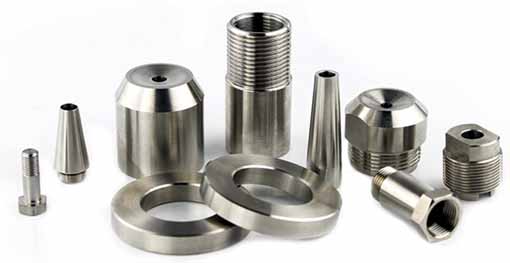Cylindrical parts with milling features on compound corners or multiple faces are very common. A factory that provides services for large-scale equipment and oil companies, and produces parts that require precise 5-axis contour machining and finishing. B-axis machine tools are usually used to manufacture slotted shafts, and to machine grooves and cuts on compound angles. Such factories also use B-axis machine tools to process complex polyhedrons, such as tool bodies and tool holders.
The size of the parts processed by the B-axis machine tool is various. It can process watch gears as small as 0.04 直徑英吋, or metal castings as large as 20 直徑英吋.
以滿足客戶不同的加工需求, Methods Machine Tool Company 提供兩種型號的配備 B 軸的 Nakamura Tome 工具機. STW-40 工具機配備標準 40 工位自動換刀裝置,專為加工大型和重型零件而設計. 例如: 鑄件和鍛造件, 並可加工工件達 17 直徑英吋. 然而, 回應客戶需求, 方法工具機公司現在可以提供更小型號的 B 軸工具機, 即NTJ (B軸刀塔). The weight of this machine is only about half of the STW-40. The advantage is that it occupies a small area and is easy to maintain and operate compared to large-sized machine tools. NTJ is most suitable for machining smaller B-axis parts, such as joint tools up to 8 直徑英吋.
Both of these models are equipped with a bar feed function, so it is possible to feed raw materials to the machine tool in a continuous flow method, and then perform B-axis cutting. 如有必要, this processing can also be performed on part features equipped with compound angles. When evaluating parts and bar feed options, the factory should consider the size of the raw material. Although a large B-axis machine tool equipped with a bar feed function can handle larger bars, it is impractical to always load such specifications into the machine tool. Because bars are generally relatively long (up to 12 feet is not uncommon), human or robot lifting may be too heavy. Large materials are also difficult to cut, especially in cutting bars.

圓柱件複合加工
 English
English العربية
العربية 中文(漢字)
中文(漢字) Čeština
Čeština Dansk
Dansk Nederlands
Nederlands Suomi
Suomi Français
Français Deutsch
Deutsch Italiano
Italiano 日本語
日本語 ಕನ್ನಡ
ಕನ್ನಡ 한국어
한국어 Português
Português Русский
Русский Slovenčina
Slovenčina Español
Español Svenska
Svenska Türkçe
Türkçe

